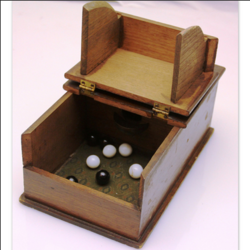Blackballing
(voting procedure) | |
|---|---|
 Image:A masonic ballot with blackballing | |
| A voting procedure used for secret ballots |
Blackballing is a ballot voting procedure used for secret ballots. Traditionally, black and white balls are used, where white indicates a yes vote and black a no vote.[1]
The principle of such election rules in a club is that it is self-perpetuating to preserve the current ethos (and exclusivity) of the club, by ensuring that candidates are congenial to (almost) all the existing members; i.e., new members are elected by unanimous or near-unanimous agreement of voting members. A difference of opinions could be divisive, so that an election must be taken secretly as well as correctly.
The number of votes in support is often irrelevant, except to prove a quorum. Whilst in many such cases even a single black ball will be fatal to the candidate's election, rules in larger clubs ensure that a single member cannot exercise a veto to the detriment of the future of the club. For example, two black balls are required to exclude; a limited category or committee of members vote, rather than all members; or in the event of a blackball, the election may be repeated immediately to ensure that there is no mistake, or after a fixed period to allow further information or opinions to be discussed discreetly. A variant sometimes used is that all incoming candidates are voted on as a group; if the group as a whole is blackballed, then each member must be voted on individually.
Balloting took place as early as ancient Athens. In particularly intricate form, balloting was used during the Middle Ages in the election of officials in some Italian cities, such as Venice and Florence. The purpose of this method of election is to prevent, as far as possible, any undue influence on the election by authorities or influential persons.
Blackballing is traditionally used in closed societies such as social clubs and Masonic Orders.